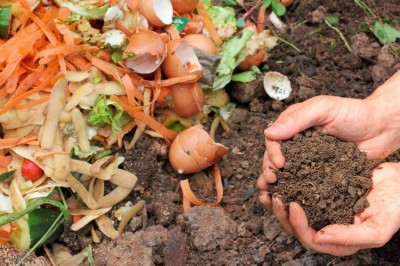Composting in the Winter - Can it be Done?

The ambient heat of spring and summer are ideal for composting, but that does not rule out winter composting. Do you really want to give up a quarter of the year as unproductive time? That is three long months of adding organic waste to the trash stream instead of the compost pile. Learn a few ways to improve your composting technique for winter, and you can create rich, black soil for your garden all year round.
Feeding Time
The microbes that hungrily consume your kitchen scraps, lawn litter and some household waste can do their work year-round. Feed them a balanced diet that helps keeps the temperature right, despite winter's chill. The bacteria and fungi will slow down their consumption, but they still need to eat. In winter especially, carbon-rich brown matter and nitrogen-rich green matter must be properly balanced to sustain the microbes. When they eat, they give off heat. Ready sources for carbon:
- ashes (from your fireplace or wood stove, in small quantities)
- brown leaves
- sawdust
- shredded newspaper
- straw
Winter sources for nitrogen:
- alfalfa pellets
- blood meal
- chicken and rabbit manure
- coffee grounds
- houseplant cuttings
- vegetable and fruit peels
Portion Control
You can help the microbial population along by shredding everything to four-cm pieces or smaller. This pre-digests the brown and green materials for the cold, slow-acting microbes. The smaller size helps create an insulating blanket, too, for the compost core. Layer methodically, always alternating brown ingredients and green matter. Remember that winter air is dry, too, despite snow and sleet. If your compost pile goes too long without natural precipitation, dampen but avoid soaking it.
Insulation
Your winter compost needs insulation from the worst winter chills. Avoid active turning, to let the core build up and sustain heat. Insulate your compost, too:
- cardboard, brown leaves or straw to cover the pile
- move a compost tumbler out of the wind and into a shelter (garage, outbuilding, greenhouse)
- snow can effectively insulate a pile kept on the lee side (away from the wind) of a fence, wall or outbuilding
An excellent method of burrowing for winter composting requires some fall planning. Your goal is to get the ground’s natural insulating properties to protect your compost: Dig We Must—before the ground gets too hard, dig a trench. Fill it to ground level with your compost ingredients, and protect it from wind with straw bales. Control moisture from rain and snow by covering or uncovering the top with a tarp Treasure Can—Convert a plastic trash into a compost treasure can by cutting off the bottom, poking air holes in the top 30 cm of the can’s walls. Before the ground freezes, dig a 30-cm hole as big as the can, then sink the can into it. Insulate the can above ground with straw bales, using dry leaves as “mortar” between the bales. Put some starter compost in the can bottom and add ingredients as they become available, in alternate layers of green and brown. Keep the lid tight when not adding material.
Bring It Indoors
Bring the compost pile indoors, into relative warmth, to create perfect garden soil:
- Practice vermiculture (worm composting) that is odorless and ideal for indoor use, though the trays need a bit of space.
- Keep a well-insulated, sealed composter in the garage—properly balanced carbon and nitrogen ingredients will keep odors to a minimum
- Anaerobic composting—fermenting organic waste without oxygen; you need Bokashi mix, and your final product might need a little composting time, but you can get things started, odor-free, indoors
For help getting started with composting in any season, contact us at Legends Landscape Supplies.


 LANDSCAPE PROFESSIONALS
LANDSCAPE PROFESSIONALS